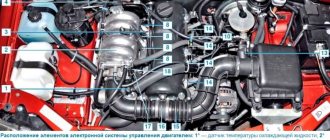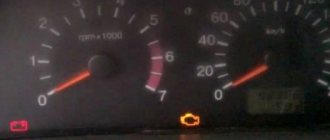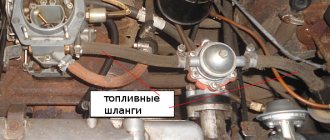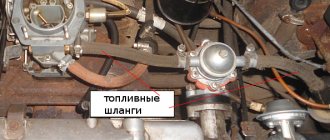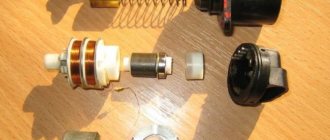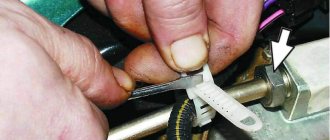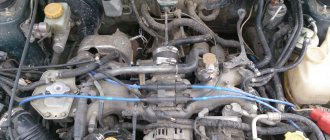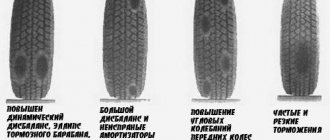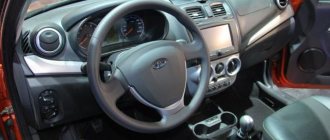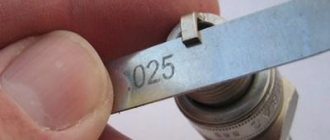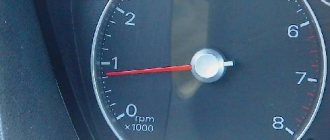There were no signs of trouble: the car started up easily and worked perfectly. The time comes to take your foot off the gas pedal and the revs immediately begin to drop. The car stalls at idle, stops and the ride suddenly stops. Most car owners have encountered a similar situation with gasoline and diesel at least once in their lives.
The most common reasons:
- incorrect operation of the idle speed sensor;
- failure of the sensor responsible for the throttle position;
- throttle contamination;
- contamination of the carburetor or injector in the engine.
Since these reasons are little related to each other, diagnostics can take a lot of time, and not every car owner is able to carry it out on their own. These breakdowns are not considered serious and their elimination does not require much effort.
The cause of a stalled engine is the spark plugs
In 50% of cases, the problem is due to the fact that the spark plugs simply do not produce a spark. This failure occurs as a result of 3 reasons:
- contacts become clogged;
- plaque forms along the entire contour of the candle;
- malfunction when supplying voltage to the spark plug.
However, the most popular is still black carbon deposits on the spark plugs, which prevents the spark from appearing or causes it to work periodically.
Tip: if the spark plug set malfunctions, you will hear a “triple” sound that is uncharacteristic of the engine. In this case, the car will jerk strongly while moving. As a result, the engine will either stall on its own, or you will need to turn it off and turn the ignition on again.
If you see dirt on the surface of the contacts, this indicates the need to replace a low-quality type of fuel or check the serviceability of the oil supply systems. It is the oil supply adjustment sensors that can splash the spark plugs with it if there is a problem. Also, oil that appears on a set of spark plugs may indicate serious damage to components in the engine cylinders. Be sure to check the engine at a car service center. Otherwise, further operation may lead to expensive replacement of jet rods and even the entire set of pistons.
If you systematically use low-quality gasoline samples, you may find a red-brown coating on the contour of the spark plug. In this case, cleaning will not help - it is better to immediately replace the entire set after a new refill. If you find that the car periodically turns off at full speed, but starts easily even with clean spark plugs, then the problem lies in the electrical wiring.
spark plug
The cause of a stalled engine is a power supply failure
In this type of problem, 3 reasons may be involved:
- Poor contact with the terminals of the new battery;
- Detection of poor contact or breakdown along the entire length of high-voltage wires;
- The appearance of malfunctions in the generator or ignition coil system of the car.
If the problem lies in damp high-voltage wires, then it is best to replace them completely along with the battery contacts. If the terminals make poor contact, you need to carefully clean them with sandpaper and try to reconnect them. If the generator is found to be inoperable, the problem usually boils down to problems in the following parts:
- Broken timing belt;
- There is a malfunction inside the housing of the unit itself.
A problem with the generator is easily detected when the corresponding indicator on the dashboard turns on. In addition, if there is insufficient energy supply, the backlight of the on-board panel will gradually fade, and a set of other diagnostic sensors will show incorrect values.
Advice: if when you press the gas the car jerks, then stalls and cannot start, then the problem is related to the failure of the ignition coils. It is best to replace these parts in a car service using special equipment.
From the list of reasons that are directly related to the car engine, you need to move on to problems that arise in the fuel and air supply systems, as well as malfunctions of components responsible for exhaust gas removal.
Ignition coil
timing belt
Complete sabotage
The most deplorable situation, the engine does not start at all.
First of all, you need to maintain composure and not scold the car itself. Only after this, we calmly begin to find out the reason why the engine does not start.
Do not allow the battery to be severely discharged by pointlessly rotating the engine crankshaft, the energy will still be useful to you, but where you will charge the battery if you are far from home is the question. Although for the electronic unit itself 8 Volts will be quite enough. But, of course, they won’t be enough for the starter.
When you have calmed down, be sure to check:
- How does the fuel pump work and is there any fuel in the tank?
- Is there ignition?
- Is the engine crankshaft timing sensor functioning?
- Have the injectors failed, although the failure of several injectors at once is too much, this happens very rarely.
- The ECU is working. But this device also fails very rarely.
Fuel supply faults
It is quite easy to find out that the car stalls while driving due to the engine being “choked” with the fuel mixture - during a long drive you will find that the signal of the sensor responsible for this function is constantly on.
Here the problem lies in low-quality fuel, which does not quickly “ignite” from the spark of the candles. It can also be caused by gasoline not meeting the requirements for the octane number specified in the vehicle specifications. If there are problems with fuel, the gas pedal will be pressed all the way, and the car will not begin to gain speed. In addition, the car will periodically stall when the clutch is engaged.
Another symptom indicating problems with fuel is the appearance of problems with the car after refueling. The problem is characterized by a rapid drop in engine power at full speed, as well as when constantly changing gears. The way out of the situation is to completely drain the bad fuel mixture, wash the engine and all the fuel system pipes.
Also, the car will constantly stall if there is an interruption in the supply of the fuel mixture. This may be due to contamination in the following system components:
- Dirt in the fuel filter;
- Problems with injector nozzles;
- Dirty throttle valves;
- Fuel pump power failure.
The main symptom of a malfunction of these parts is that there will be a gradual drop in the power of the car’s engine, after which the car will stall even after sharply pressing the gas pedal. If you do not release the clutch carefully when changing gears, this will also cause the engine to stall.
The contamination of the fuel filter and fuel pump can be judged by the unstable operation of the machine even during idling and during rapid braking (when the supply of the fuel mixture decreases). And if the performance of fuel filters can be easily established during an external inspection and eliminated by replacing them, then to detect other causes, you need a full-fledged computer diagnostics, which can only be carried out in a car service center.
Another reason for a stalled car associated with the operation of the fuel pump is boiling gasoline in the fuel pump. This happens mainly in hot weather when the car is moving slowly or standing on the highway in traffic jams. The car will start to stall while driving, but when you turn on the idle speed and press the clutch, it will start again.
If boiling occurs, it is better to stand in a traffic jam with the engine turned off and gradually cool the car. After 5-10 minutes, the car's operation will be stable again.
Advice: if you recently did a wheel alignment with your own hands on a VAZ-2107, then to cool the car, proceed as follows - throw a piece of cloth made of dense material over the fuel pump body, which you first moisten with cold water.
Injection engines
If a car with an injection engine stalls while driving, then there may be several problems of this kind:
- The oxygen enrichment system for the fuel mixture is faulty.
- Broken oxygen sensor.
- The intake manifold is malfunctioning.
- Fuel injectors are partially or completely dirty.
- The cooling system of the unit is broken.
If the owner himself is not sure of the cause of the breakdown, the same diagnostics are needed, after which repairs are already carried out. You can describe some of the reasons in more detail, but do not forget that there can be a lot of them, and they are all different - it depends on the make of the car, the country of origin, the type of engine, etc.
Malfunctions in the air mixture supply system
Here the problem lies either in a clogged air filter or in the failure of the regulator responsible for idling the car. In this case, your car will stall all the time when you gain speed or when you release the gas when you release the accelerator.
To solve the problem, remove and inspect the air filter. If there is serious contamination or chips, replace it. To diagnose and replace the idle speed regulator, you will need the help of qualified car service employees.
Recommendations
So, the car stalled while driving, what to do next:
- Using the inertia of movement, push the car off the roadway, no matter whether it is a city road or a highway.
- Turn on the alarm.
- It is mandatory to install an emergency sign at the back of the car: there are plenty of fans of high-speed driving everywhere, there is no need to create an emergency situation.
- Put the car on the handbrake.
Option 2 for further developments:
- Do the repairs yourself.
- Find a way to transport the car to the service.
In order to avoid such unpleasant and unexpected moments when the car stalls while driving, you need to follow simple rules:
- Carry out vehicle diagnostics at a service center as often as possible.
- Carry out preventive maintenance and inspection of the machine yourself.
- Monitor the condition of parts and replace them in a timely manner so that the machine does not break down in unexpected places.
You should always have a tool with you to repair minor damage, as well as a can of gasoline to avoid stopping due to its absence.
A car that stalls while driving can create a dangerous situation no matter where it occurs. If you are in motion, even at low speed, and your car suddenly stalls, then it is quite possible that someone, unable to brake in time, will crash into your rear bumper.
And if the car stalls on a busy highway, then there is a high probability of getting into a very serious accident. If your car stalls while driving and won't start, the possible reasons can be very varied. In this article we will look at the 6 most common reasons for this behavior of a car on the road, as well as methods for solving this problem.
Car exhaust system problem
The engine may also stall if the tubes responsible for removing gases are malfunctioning. At full speed, the car will quickly begin to “choke”, and pressing the gas pedal completely stops the engine. Malfunctions in the operation of the exhaust pipe system in 90% of cases are caused by contamination and clogging of the muffler. However, the catalyst may also fail.
In the first case, carefully clean the muffler and remove foreign objects from there. If there are problems with the catalyst, conduct a complete diagnosis of the exhaust system and replace this element.
car muffler
How to avoid stalling at a traffic light as a beginner
Many novice drivers have a question about how not to stall at a traffic light due to poor driving skills and the ability to start with a manual transmission. To avoid such problems, here are the following tips:
- Depress the clutch fully (important!!!) just before engaging first gear;
- You can press the clutch at a traffic light as soon as the yellow light turns on;
- In neutral gear or with the clutch already depressed, press the gas pedal once or twice in order to increase the oil pressure in the engine and enrich the fuel mixture;
- select the optimal engine speed at the start (for a flat surface they are about 1500 rpm, when climbing - more, when descending - less, you can also navigate by the sound of the engine);
- you need to depress the clutch pedal smoothly, without jerking; you must not drop the clutch at the moment of starting;
- when the clutch “grabs” you need to fully depress the clutch pedal and at the same time add gas to accelerate the car (you can even add gas a little earlier).
All these skills should be practiced until they become automatic, but it is better to do the training away from dense city traffic!
What to do if cars with automatic transmission stall?
If your vehicle has an automatic transmission, then the problem should be found in the electrical supply. If you abruptly switch from one gear to another, or while switching gears while braking, the settings may be distorted, and the on-board computer will receive a signal to turn off the engine.
Also, models with automatic transmission may stall due to malfunctions of the hydrodynamic transformers of the gearbox. This problem mainly manifests itself during acceleration and requires urgent intervention from car service specialists.
Diagnostic sequence
No specialist can give any precise recommendations on the diagnostic sequence, but if the problem of a suddenly stalling engine appears periodically, you can wait a little and try to determine under what circumstances it occurs. It would also be a good idea to visit specialized forums dedicated to the problems of a particular make and model of car.
To carry out the most accurate diagnostics, it is recommended to connect the car to a special diagnostic device, which can be found at any specialized service station.
